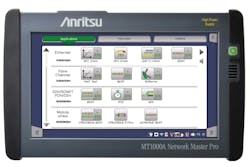Evaluating Time Sync Variation by Measuring PTP Wander
–Corporation has added a function for
PTP (Precision Time Protocol, IEEE1588v2) wander is a method to evaluate frequency variations as low as 10 Hz, and Anritsu has added the functionality to its smallest-in-class 100 Gbps Network Master Pro MT1000A. PTP wander is a key index expressing long-term time synchronization stability, and with this improved time sync measurement, the MT1000A is a powerful tool in assuring 5G network quality.
Implementing low-latency communications requires support for MEC (Multi-access Edge Computing) architectures in 5G networks, with precise time synchronization to ensure communications between MEC systems. Using SyncE (Synchronous Ethernet) network technology with PTP assures high-accuracy and -stability synchronization for high speeds and low latency. Anritsu instruments have features like built-in jitter and wander test functions to capture instabilities in networks like SDH/SONET and modern transport networks.
The MU100090B is a GNSS (Global Navigation Satellite System) disciplined oscillator supporting the GPS, QZSS, Galileo, Beidou, and GLONASS, providing a UTC-traceable reference time and 10-MHz frequency signals, supplied to the portable MT1000A, which supports SyncE and PTP up to 25 Gbps to measure network time synchronization accuracy.
SyncE Wander MU100011A-021 and MU100090B software aids ITU-T recommended pass/fail evaluation of network-supplied Ethernet frequency accuracy. Site Over Remote Access MX109020A software can control and monitor multiple MT1000A units located in separate locations from a central office.
GLONASS, China's Beidou, and Japan's QZSS.
